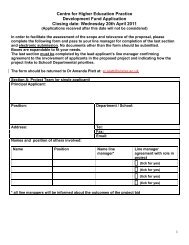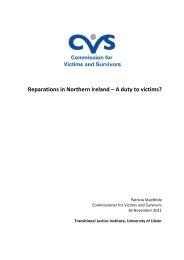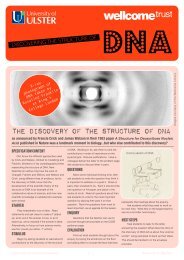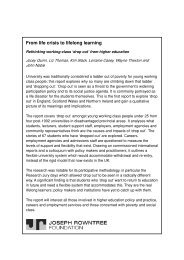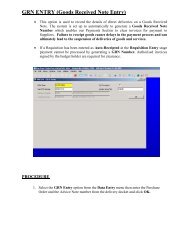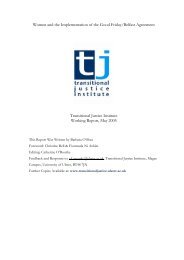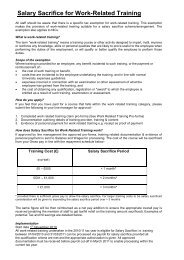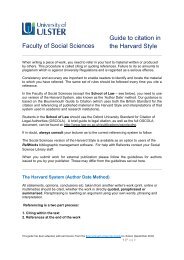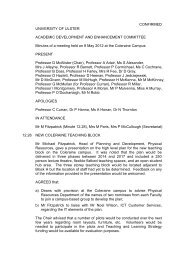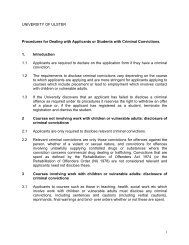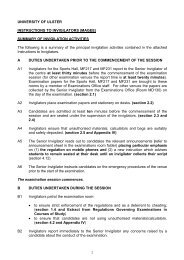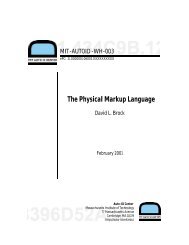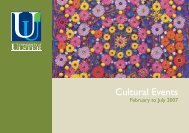Assessment Audit Tool - University of Ulster
Assessment Audit Tool - University of Ulster
Assessment Audit Tool - University of Ulster
You also want an ePaper? Increase the reach of your titles
YUMPU automatically turns print PDFs into web optimized ePapers that Google loves.
<strong>Assessment</strong> <strong>Audit</strong> <strong>Tool</strong><br />
Version May 2004<br />
An <strong>Audit</strong> is a good way to initiate discussion and development on an issue. It enables you<br />
to make clear the range <strong>of</strong> activities which may contribute to the issue and the process can<br />
reassure colleagues that quite a lot <strong>of</strong> work may already be developed in the area. The<br />
process can also recognise local autonomy and priorities, within an institutional framework,<br />
and can:<br />
• encourage development <strong>of</strong> a strategic plan to clarify how assessment practices can be<br />
developed;<br />
• identify how far and in what area development should take place;<br />
• give recognition to existing activity which contributes effectively.<br />
However an <strong>Audit</strong> also serves broader purposes:<br />
• raising awareness by staff <strong>of</strong> practice in general and <strong>of</strong> the institution’s plans;<br />
• revealing or clarifying links between the aspect being audited and plans and strategies<br />
in other areas;<br />
• engaging a wider constituency within the academic community;<br />
• facilitating dialogue and development within and between teaching units.<br />
The purpose <strong>of</strong> this audit is developmental, not simply to come up with an overall score<br />
for the course. It is designed to help teachers consider the content and design <strong>of</strong> a course<br />
with respect to the issue <strong>of</strong> assessment and to see where they could improve the course<br />
to better address this issue.<br />
The <strong>Assessment</strong> <strong>Audit</strong> <strong>Tool</strong> can be downloaded from the LTSN Bioscience website:<br />
LTSN Centre for Bioscience<br />
School <strong>of</strong> Biomedical Sciences<br />
<strong>University</strong> LTSN Centre <strong>of</strong> for Leeds Bioscience<br />
Leeds http://bio.ltsn.ac.uk/resources/<strong>Audit</strong>.htm<br />
LS2 9JT<br />
http://bio.ltsn.ac.uk/resources/<strong>Audit</strong>.htm<br />
The audit can be changed to suit your requirements. All we ask is that you clearly<br />
acknowledge LTSN Bioscience as the originator. We would appreciate it if you would let us<br />
know that you are using the audit tool and the nature <strong>of</strong> any changes you have made as a<br />
result <strong>of</strong> your analysis.<br />
Tel: +44 (0) 113 343 3001<br />
Fax: +44 (0) 113 343 5894<br />
Email: ltsnbioscience@leeds.ac.uk 1<br />
http://bio.ltsn.ac.uk
LTSN Centre for Bioscience<br />
http://bio.ltsn.ac.uk/resources/<strong>Audit</strong>.htm<br />
How to use the <strong>Assessment</strong> <strong>Audit</strong> <strong>Tool</strong><br />
Version May 2004<br />
The audit should be carried out with respect to the totality <strong>of</strong> provision within a course. The<br />
numeric scoring system allows for the situation where and issue might be addressed but<br />
only superficially or at the wrong time. Only score 4 if you believe the course optimally<br />
deals with the audit point.<br />
In the various aspects <strong>of</strong> assessments score (0-4) for each <strong>of</strong> the audit points depending<br />
on how closely you believe these audit points are optimally achieved in the course being<br />
audited.<br />
Score 0 if the audit point has not been serious considered at all.<br />
Score 1-4 if the audit point has been considered but reflection indicates that it is poorly (1),<br />
partially (2), adequately (3) or optimally (4) satisfied. Make a subjective judgement and<br />
score accordingly. Think about it from the student's point <strong>of</strong> view as well as that <strong>of</strong> the<br />
course team.<br />
Having completed the employability audit you should analyse each <strong>of</strong> the audit points with<br />
a score <strong>of</strong> 2 or less:<br />
i) What possible options could be envisaged which would satisfy the audit point?<br />
ii) Do resource or other constraints make any <strong>of</strong> these options unrealistic?<br />
iii) At what point in the course could appropriate changes be made?<br />
iv) Which changes would most benefit employability aspects <strong>of</strong> the course?<br />
v) Can a realistic action plan be formulated to introduce these changes into the<br />
course before the next intake <strong>of</strong> students?<br />
Are there potential quick wins? There may be something that you or your colleagues<br />
could do very easily that would not cost a lot in terms <strong>of</strong> resources or time.<br />
Are there changes that require longer term planning? Does the change require<br />
agreement <strong>of</strong> others/resource allocation/time to implement?<br />
Collect all your action points into the action plan at the back <strong>of</strong> the audit.<br />
Having instituted changes as a result <strong>of</strong> the audit the process should be repeated in 12-24<br />
months.<br />
2
1. Are the assessment methods appropriate to the learning objectives?<br />
1.1 Are the learning objectives (i.e. the changes in the student's knowledge, skills and<br />
attitudes) explicit for the module and for each constituent element piece <strong>of</strong> work where<br />
appropriate?<br />
1.2 Are the different types <strong>of</strong> element in the Learning Objectives reflected in the<br />
assessment? (e.g. knowledge, understanding, skills, attitudes etc)<br />
1.3 In setting the Learning Objectives is consideration given to the learning objectives in<br />
other concurrent or previous modules?<br />
1.4 Is the different achievement in each Learning Objective separately identifiable by the<br />
student in the overall assessment?<br />
1.5 Are assessment methods/conditions adjusted appropriately for disabled students?<br />
1.6 Do students experience the method <strong>of</strong> assessment before it is used summatively?<br />
Either in this module or in a previous module?<br />
1.7 A single type <strong>of</strong> assessment (e.g. all MCQs) may disadvantage some students. Is there<br />
a variety <strong>of</strong> assessment methods used in different circumstances?<br />
[ For example knowledge can be assesses using MCQ, EMQ, SAQ, essays marked for<br />
factual content etc. To what extent are different assessment techniques use to give the<br />
student a variety <strong>of</strong> ways in which to demonstrate their abilities?]<br />
LTSN Centre for Bioscience<br />
http://bio.ltsn.ac.uk/resources/<strong>Audit</strong>.htm<br />
Section score (% <strong>of</strong> section total)<br />
Version May 2004<br />
Score<br />
2. The assessment methods used - are they known to provide a secure assessment appropriate<br />
to the teaching style?<br />
2.1 To what extent are the methods subjective?<br />
2.2 Are assessments made from written and agreed marking schemes?<br />
2.3 If multiple markers are used is uniformity <strong>of</strong> marking tested and, if necessary,<br />
compensated for?<br />
2.4 If double marked is there a mechanism OTHER than taking the average to resolve<br />
significant differences?<br />
2.5 Is marking done anonymously [If machine marked score 4]<br />
Score<br />
3
Version May 2004<br />
2. The assessment methods used - are they known to provide a secure assessment appropriate<br />
to the teaching style? (cont.)<br />
2.6 Are the assessment methods appropriate to the teaching style used?<br />
[e.g. if the course is primarily taught using problem-based-learning it would be<br />
INappropriate for the assessment to be wholly based on MCQ designed to test factual<br />
knowledge].<br />
2.7 Are the students clear as to what would be deemed to constitute plagiarism and has<br />
assessment been designed to discourage/prevent plagiarism?<br />
2.8 Are known mark sets included in the mark spread sheets to demonstrate accuracy <strong>of</strong><br />
mathematical processing/combining <strong>of</strong> marks?<br />
2.9 Is there external input into the assessment process?<br />
LTSN Centre for Bioscience<br />
http://bio.ltsn.ac.uk/resources/<strong>Audit</strong>.htm<br />
Section score (% <strong>of</strong> section total)<br />
3. Are there published marking criteria and grade descriptors available to the student?<br />
3.1 Are there grade descriptors available to the students?<br />
3.2 Are these known to and followed by the staff doing the marking?<br />
3.3 Are there exemplar answers?<br />
3.4 Are exemplar answers available at different grades?<br />
3.5 Are the grade descriptors congruent with those on other modules taken by the<br />
students?<br />
Section score (% <strong>of</strong> section total)<br />
Score<br />
Score<br />
4. How is pass mark decided? Peer or criterion referenced? [Peer referenced is here defined as the<br />
pass mark/grade boundaries being defined in the light <strong>of</strong> the actual achievement <strong>of</strong> the student body<br />
as a whole. Criterion referenced is where these are decided independently <strong>of</strong> the actual<br />
achievement <strong>of</strong> the student body.] If peer referenced divide score for this complete aspect by 2.<br />
4.1 Is the mark distribution for each piece <strong>of</strong> work known and considered?<br />
4.2 Is the distribution <strong>of</strong> marks in the module compared with that <strong>of</strong> previous years<br />
cohorts?<br />
4.3 Is data available and used to compare the distribution <strong>of</strong> marks <strong>of</strong> a student cohort in<br />
this module with that in other concurrent modules?<br />
Score<br />
4
Version May 2004<br />
4. How is pass mark decided? (cont) Peer or criterion referenced? [Peer referenced is here<br />
defined as the pass mark/grade boundaries being defined in the light <strong>of</strong> the actual achievement <strong>of</strong><br />
the student body as a whole. Criterion referenced is where these are decided independently <strong>of</strong> the<br />
actual achievement <strong>of</strong> the student body.] If peer referenced divide score for this complete aspect<br />
by 2.<br />
4.4 Is there external moderation <strong>of</strong> the marks?<br />
4.5 IF PEER referenced: are the grade boundaries set by a standard method across<br />
different modules?<br />
4.6 IF CRITERION referenced: does more than one person determine and agree the grade<br />
boundaries?<br />
5. Is assessment timely and progressive throughout the course?<br />
LTSN Centre for Bioscience<br />
http://bio.ltsn.ac.uk/resources/<strong>Audit</strong>.htm<br />
Section score (% <strong>of</strong> section total)<br />
5.1 Does assessment provide a monitor <strong>of</strong> student performance throughout the module?<br />
5.2 Is there time to allow students to respond to a poor assessment before the end <strong>of</strong> the<br />
module?<br />
5.- Is assessment timely with regard to:<br />
5.3 the speed with which the results are available to the students?<br />
5.4 in relation to other assessed work on the module?<br />
[So students know the results and have had feedback before the next piece <strong>of</strong><br />
assessed work?]<br />
5.5 in relation to other assessment on other modules?<br />
[So the totality <strong>of</strong> the assessment as experienced by the students is reasonably<br />
distributed and does not all take place in an unreasonably short period.]<br />
6. Is feedback provided?<br />
6.1 On all in course assessments?<br />
6.2 On the end <strong>of</strong> module assessment?<br />
6.3 To all students?<br />
Section score (% <strong>of</strong> section total)<br />
Score<br />
Score<br />
——<br />
Score<br />
5
6. Is feedback provided? (cont.)<br />
6.4 As written comments sufficiently detailed to enable the student to identify particular<br />
weaknesses?<br />
6.5 With omissions as well as errors?<br />
6.6 Do you know that all students access the feedback provided?<br />
6.7 Are students performing poorly counseled (on a one-one basis)?<br />
6.8 Does counseling take into account performance on other modules?<br />
7. Are resit/second chance arrangements known to students?<br />
LTSN Centre for Bioscience<br />
http://bio.ltsn.ac.uk/resources/<strong>Audit</strong>.htm<br />
Section score (% <strong>of</strong> section total)<br />
7.1 Are these arrangements written, available to the students and explicit with regard to<br />
format and material covered?<br />
7.2 Is the date/time <strong>of</strong> any resit exams known to the students at least 3 months before it<br />
takes place?<br />
7.3 Are the Learning Objectives the same?<br />
7.4 Are resit candidates given effective feedback on their performance in the first sit?<br />
Section score (% <strong>of</strong> section total)<br />
8. What are the students’ views on the quality and usefulness <strong>of</strong> the assessment?<br />
8.1 Are the students’ views on the assessment processes known and elicited each year?<br />
8.2 Is this data obtained from all the students other than those absent because <strong>of</strong> illness?<br />
8.3 Are they treated as a homogeneous group (score 1) or are student views fragmented<br />
into those <strong>of</strong> the various sub-groups making up the student body? (score 4) [e.g. year 1<br />
and year 2 taking the same module? Students on different courses but taking the same<br />
module? If the students ARE a homogeneous group (i.e. all taking the same courses and<br />
modules) score 4. ]<br />
Section score (% <strong>of</strong> section total)<br />
Version May 2004<br />
Score<br />
Score<br />
Score<br />
6
THIS ASPECT IS CALCULATED BUT NOT SCORED<br />
LTSN Centre for Bioscience<br />
http://bio.ltsn.ac.uk/resources/<strong>Audit</strong>.htm<br />
Version May 2004<br />
Proportion <strong>of</strong> total teaching time allocated to assessment. It is appreciated that individual<br />
students will spend different amounts <strong>of</strong> time involved with leaching/learning/assessment activities.<br />
Use estimated average values.<br />
a). Total hours spent by teachers (including demonstrators, PG tutors etc) on assessment<br />
in this module. This includes time spent setting assessments, marking student work,<br />
compiling and processing assessment data, marking lab/project work (include that<br />
proportion <strong>of</strong> time spent in labs which is actually involved in assessing the performance <strong>of</strong><br />
the student at the bench if this is done).<br />
b). Total hours <strong>of</strong> teaching time spent by staff in direct contact with students. This is<br />
usually time-tabled time for teachers (<strong>of</strong> all levels) to be in contact with students. If<br />
students are taught for 1 hour in, say, 5 small groups, then 5 hours <strong>of</strong> teacher time would<br />
be involved. Do NOT include preparation time or time spent on assessment <strong>of</strong> students.<br />
c). Total hours spent by A student in being assessed. Include examination and viva time,<br />
time spent actually writing assessed course work (e.g. essays, practical write-ups etc) but<br />
NOT the time spent preparing the material. Estimate where necessary. Assume course<br />
work takes 0.5hr to write 1 page.<br />
d). Total hours for which A student is involved in any form <strong>of</strong><br />
teaching/learning/assessment activity (lectures + practicals + self-directed + directed +<br />
tutorials+others etc) on this module. This is the total hours you would expect this module<br />
and the work associated with it to occupy the student. Estimate where necessary.<br />
e). How proportional is the staff time spent in assessment to the marks awarded? How<br />
proportional is the student time spent in completing the work for an assessment to the<br />
marks awarded? [For each assessed item consider the proportionality between the<br />
fraction <strong>of</strong> the total marks awarded and the assessment time devoted to it. Consider this<br />
for both the staff and the students. This item is not represented numerically but you<br />
should note areas where the time spent by staff in completing the assessment is very large<br />
compared with the proportion <strong>of</strong> marks given for the work]<br />
Hrs<br />
-----<br />
7
Version May 2004<br />
Analyse each <strong>of</strong> the audit points with a score <strong>of</strong> 2 or less:<br />
i) What possible options could be envisaged which would satisfy the audit point?<br />
ii) Do resource or other constraints make any <strong>of</strong> these options unrealistic?<br />
iii) At what point in the course could appropriate changes be made?<br />
iv) Which 4 changes would most benefit work placements on the course?<br />
v) Can a realistic action plan be formulated to introduce these 4 changes and others<br />
into the course before the next intake <strong>of</strong> students?<br />
Are there potential quick wins? There may be something that you or your colleagues<br />
could do very easily that would not cost a lot in terms <strong>of</strong> resources or time.<br />
Are there changes that require longer term planning? Does the change require<br />
agreement <strong>of</strong> others/resource allocation/time to implement?<br />
Action Plan<br />
Make a note <strong>of</strong> the resources you will need and whose help will be required.<br />
1.<br />
2.<br />
3.<br />
4.<br />
LTSN Centre for Bioscience<br />
http://bio.ltsn.ac.uk/resources/<strong>Audit</strong>.htm<br />
8
LTSN Centre for Bioscience<br />
http://bio.ltsn.ac.uk/resources/<strong>Audit</strong>.htm<br />
Version May 2004<br />
9



